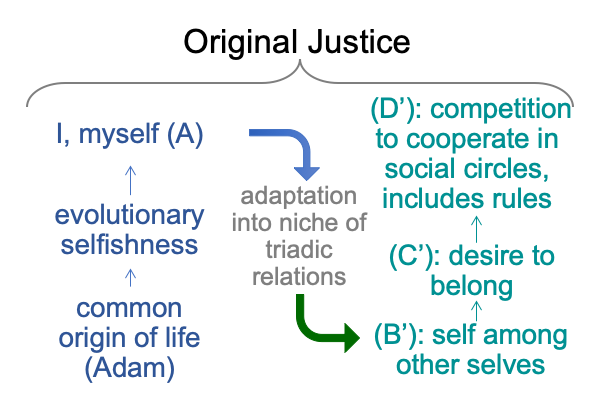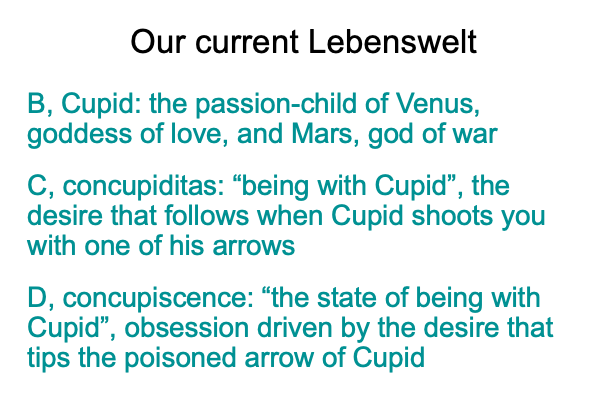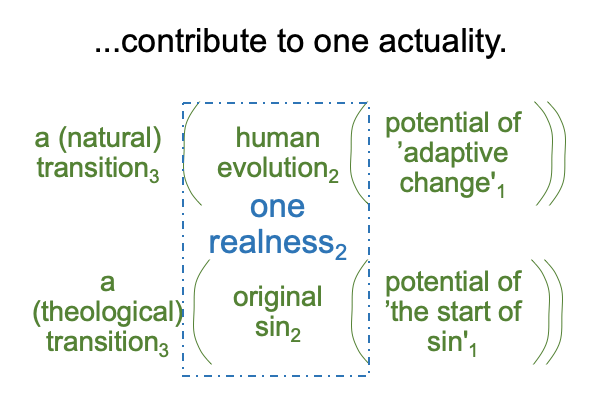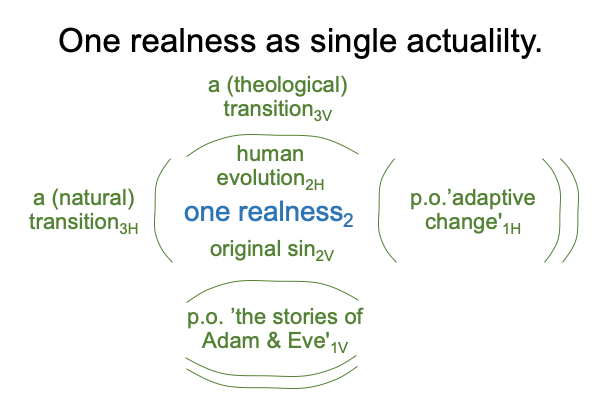0071 Thomas Aquinas is a theologian.
To wit, Aquinas comes up with the notion of original justice as the state of Adam before the Fall. Correspondingly, this notion should apply to humans in the Lebenswelt that we evolved in.
0072 Domning is an evolutionary biologist who is interested in theology.
To wit, Domning has read the Jesuit paleontologist, theologian and mastermind, Teilhard de Chardin. De Chardin is profoundly influenced by evolutionary theory and concludes that the stories of Adam and Eve are highly problematic. There is no way that Adam and Eve are the parents of all humans, which is the universal reality in the doctrine of Original Sin.
So, if the universal reality of Original Sin is scientifically incorrect, what does that imply?
Domning follows de Chardin in drawing the obvious conclusion. The universal reality of Original Sin must be found in the evolution of selfishness. So, selfishness must be the moral reality underlying Original Sin.
0073 But, this is not the case.
Why?
The self (B) is an adaptation to the niche of the triadic structure of judgment. The self (B) is also cupid (B’), which is a self among selves. Concupiditas (C’) is not selfish (C). Rather, it is the desire to be a self among selves, which turns into a competition to belong to a flourishing social circle (that is, concupiscence (D’), the state of competing to cooperate). Performance counts.
Cooperation within various social circles increases self-preservation and reproductive success, which in turn are adaptations into the niche of natural selection and genetics.
0074 The topic of social circles appears in Comments on Clive Gamble, John Gowlett and Robin Dunbar’s Book (2014) “Thinking Big”, available at smashwords and other e-book venues. These researchers discuss human evolution in terms of various social circles, including family (5), intimates (5), team (15), bands (50), communities (150) and later, megabands (500) and tribes (1500). As it turns out, the relative size of the mammalian brain correlates to group size. The hominins start with brain sizes typical for bands and end up with brain sizes typical of communities. The typical person keeps track of 150 other people.
Surely, the evolution of self plays a role. Perhaps, the coincidence of self (B) and cupid (B’) plays a role in the formalization of personal relations, especially in regards to larger groups, which meet seasonally (mega-band) or on rare occasions (tribe). More importantly, the realization of self (B) as relational (cupid (B’)) sets the stage for the competition to perform well in a social circle (D’).
0075 What does this mean for a freshman, who tries to keep up with hardened seniors, drinking beer at a college bar?
Surely, the freshman is trying to impress his superiors, the seniors, who are really his colleagues.
But, there is something more. The freshman is dying (figuratively, and occasionally literally) to join the team or the band.
The freshman is a cupid, saying I-myself, all the way to the porcelain throne.
0076 Would Domning regard such excess as selfish behavior on the part of the seniors (who should know better) as well as the freshman (whose mother warned him about this)?
I suppose so.
But, it is also more. The competition (to drink one more pint) stands at the threshold of a cooperative reaction (oh shit! he is about to barf! let’s get him to the can!). The competition triggers cooperation. Cooperation is the tree of life, ever fruitful, productive, innovative and challenging. Performance counts in the competition to cooperate.
0077 How is the evolution of self (B) different from the evolution of cupid (B’)?
Clearly, the freshman and the seniors are motivated by concupiditas (C’). The drinking game is an arena for expressing the desire to be among other selves. The drinking game has rules. The game has ethics. These ethics associate to concupiscence (D’).
So, the self (B) is an adaptation into the potential of the triadic structure of judgment. The self (B) is also an actuality, a self among others, a cupid (B’), who has the capacity to desire to work and belong and create with other selves (C’). Concupiditas (C’) is an adaptation that introduces culture, rules, social expectations and so forth. Concupiditas (C’) serves as the gateway to concupiscence (D’), where cooperation produces tangible results in terms of self-preservation and reproductive success.
0078 At this point, a theologian in the back of the room, yells, “Those are not the traditional definitions of cupid,concupiditas and concupiscence! This is insane. Your alternate definitions have the words precisely backwards!”
To which I reply, “Oh, you are correct. What does that imply?”













